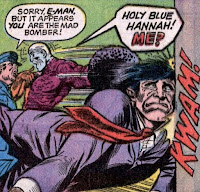With Metamorpho this was a bit different. The curious thing is despite his feature was called "Metamorpho, The Element Man", being the "Metamorpho" part more prominent than "the element man" part, Rex called himself "Element Man" since his first appearance and it was on his second appearance that his fiancee Sapphire came up with the name "Metamorpho".
In the issues to come, people started using both names to call him, however Rex contracted his name and called himself "E-Man" when leaving a message for a group of soldiers sent by the government of the United States in Metamorpho (Vol. 1) #3, November 1965. From then on, he was also known with that name and people sporadically called him like that.
It was in 1973, after 8 years Bob Haney came up with the idea of calling Metamorpho "E-man" that Charlton Comics trying to revive its superhero line with fresh ideas asked writer Nicola Cuti and artist Joe Staton to create something and the result was E-Man a sentient energy blast thrown by a nova, who after traveling through the cosmos gathering knowledge, arrives to earth, where he adopts a human form.
 Despite being a name already in use by DC Comics to refer to one of their characters, Charlton still used it taking advantage of the fact the name had not been yet trademarked to any superhero. Today, according to the United States Patent and Trademark Office (USPTO), the word E-Man has been trademarked by eight different companies (mostly in the electronics business) being one of them First Comics (the character's new house after Charlton) but to date seven of those trademarks are tagged with the "dead" status including the one from First Comics.
Despite being a name already in use by DC Comics to refer to one of their characters, Charlton still used it taking advantage of the fact the name had not been yet trademarked to any superhero. Today, according to the United States Patent and Trademark Office (USPTO), the word E-Man has been trademarked by eight different companies (mostly in the electronics business) being one of them First Comics (the character's new house after Charlton) but to date seven of those trademarks are tagged with the "dead" status including the one from First Comics. Years after the character's first appearance Cuti, stated that his inspiration to create E-Man was Plastic Man (hence the humorous touch in the series) and although we cannot insinuate Cuti took the idea from a Metamorpho comic without entering the field of speculation, it is worth emphasize the character's conception had to be modified on its early stages due to similarities with Captain Atom (another Charlton property by the time). The curious thing about E-Man is that despite being inspired in Plastic Man, his shaphe-shifting powers resemble mostly those from Metamorpho since he can transform (among other things) into self-propelled engines.
Years after the character's first appearance Cuti, stated that his inspiration to create E-Man was Plastic Man (hence the humorous touch in the series) and although we cannot insinuate Cuti took the idea from a Metamorpho comic without entering the field of speculation, it is worth emphasize the character's conception had to be modified on its early stages due to similarities with Captain Atom (another Charlton property by the time). The curious thing about E-Man is that despite being inspired in Plastic Man, his shaphe-shifting powers resemble mostly those from Metamorpho since he can transform (among other things) into self-propelled engines.
E-Man was introduced on his own book cover-dated October 1973, with an ample promotion in advance as Cuti sent letters to several fanzines informing about the upcoming series. The news could have probably reached Bob Haney but whether or not he knew about the upcoming series, it is curious that World's Finest Comics (Vol. 1) #219 (whose regular writer was Haney by the time) cover-dated also October 1973 has a back-up Metamorpho story in which the name E-Man (previously used sparsely to call Rex) was mentioned three times in five pages, a rare occurrence, perhaps to clear up who was the "true" E-Man.
Even though his first run lasted only ten issues, E-Man is nowadays an established franchise and has become a cult character with a strong fan base. Unlike Metamorpho who has lived his whole life in a widely recognized universe, E-Man has moved from small publisher to small publisher, but this has not been a problem for his fans to follow him wherever he goes and to still keep going as one of the most memorable superheroes of the last decades.
Even though his first run lasted only ten issues, E-Man is nowadays an established franchise and has become a cult character with a strong fan base. Unlike Metamorpho who has lived his whole life in a widely recognized universe, E-Man has moved from small publisher to small publisher, but this has not been a problem for his fans to follow him wherever he goes and to still keep going as one of the most memorable superheroes of the last decades.
















No comments:
Post a Comment